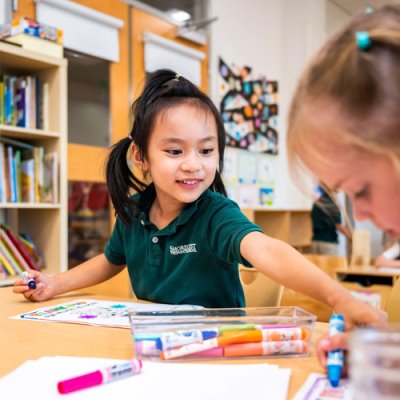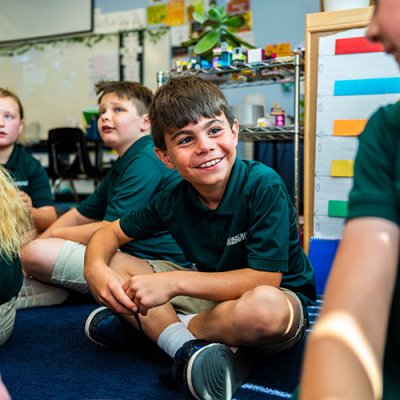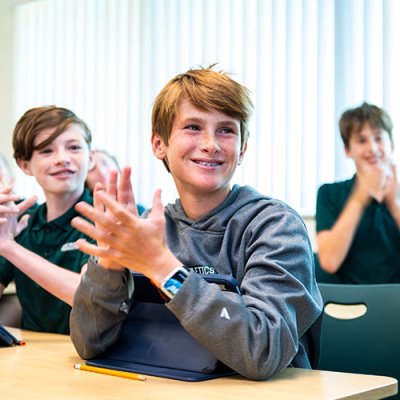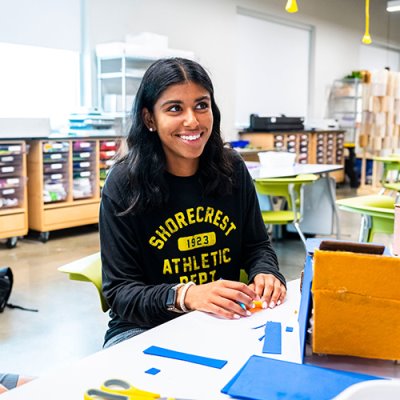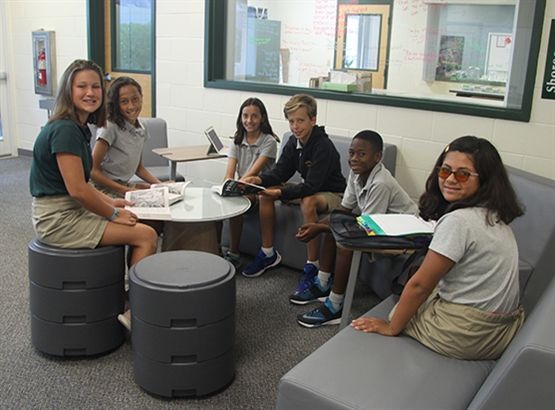

Flexible Seating and Spaces in Sixth Grade
Source/Author: Raffi Darrow, Ebytes Editor
October 06, 2017
The Mission and Vision of Shorecrest Preparatory School are lofty goals. As teachers in the Middle School use these statements to guide their daily practice, it becomes obvious that the space where learning happens needs to stimulate student curiosity, creativity and engagement.
Sixth grade teachers Amy Cobb (English) and Suzanne Wells (social studies) work in Shorecrest’s Sher and Razook 5th & 6th Grade Center. Their classroom doors are across the hall from each other, and for the past few years, the classrooms were separated by a computer lab in the center, “Jack and Jill” style. With projects, group work and fun activities, the teachers have found ways to collaborate and occasionally co-teach. The new 2017-2018 class schedule also affords them with some back-to-back class periods, allowing students to dive deep on creative ideas when necessary for longer lengths of time.
Cobb and Wells felt that their teaching could be enhanced by new classroom layouts. Uncomfortable children tend to be unproductive. When students can switch modalities - from quiet reading to hands-on learning to engaging with others or technology, retention is increased.
New furniture and floorplans can also help students control their own depth of learning. Tweens need time to take breaks and touch base with their social-emotional state, and also work in small groups to develop problem-solving skills, creativity and collaboration. The right classroom structure can provide large worktables as well as informal seating areas, helping students to become comfortable working in teams and also to seek out space for personal reflection.
A thoughtfully designed space takes all of this into consideration. Almost as though they had researched their own developmental needs, Shorecrest Middle Schoolers recognize this and ask for it.
“We surveyed the kids,” Wells explains, “and they wanted different kinds of chairs, soft seating and the ability to move around. The trend is away from everybody at a desk, to finding comfortable space in a room. If they’re comfortable they’ll be more productive.”
The students were already familiar with flexible seating and spaces from the Innovation and Design Studio created last year in Shorecrest’s Middle School Arts & Science Center by educators Cindy Williams (Art) and Christine Scoby (Technology).
“Chris and Cindy were great resources for us,” Cobb reported. “We wanted a flexible space that allowed us to mesh our curriculums together a little bit more. Once we knew some budget was available, we met with a lot of [classroom furniture] reps from different companies and looked through a lot of catalogs. We had a vision of what we wanted. We had already asked ourselves, ‘If we could dream, if we could design the perfect space, what would it be?’”
The students and their teachers are excited to now have furniture on wheels, with surfaces at varying heights for learning while sitting and standing. Oodle stools wobble like sitting on a balance ball chair, keeping those students who like to stay in motion moving - channelling their physical energy in a positive way, allowing them to focus on their work more completely.
“They love the chairs because they can perch on the back, sit backwards and have a ledge for an iPad or books. The chairs can hold their stuff, they stack, and they are on wheels so it’s easy to move them around the room. I hear almost every day from students, ‘I really like these chairs,’” Cobb shared.
One large item is missing from Cobb’s classroom. “I have no teacher desk. I have a podium as a place to plug my laptop in when it’s charging, but other than that, I sit among my students.”
Classroom technology received an upgrade too. With a wireless projector mounted on the ceiling of the classrooms, there’s no need for a desk in the center of the room with tethered technology. The interactive whiteboard is more than a dry-erase board, it is responsive to styli multiple students can use at the same time. Smaller dry-erase boards for students to hold hang on the wall in the social studies room. Two glass, magnetic dry erase boards for a wall of the English classroom are still on the way. Windows dividing the classrooms can also act as dry erase boards to help make the learning environment more engaging and fun.
The newly renovated project room between the two classrooms has bar-height tables to stand by while working. “There’s no messing around in there. They are all engaged. The windows and doors let us keep an eye and ear out,” Cobb explained.
She continues with a giggle, “I had assigned seating for years. This is new for me. I’ve told the students they have to rotate through the different chairs. Every day my classroom has a different arrangement. The students love having more choice. And we had to purge a lot because we have less storage now, so everything is clean and smooth.”
“If we’re introducing a lesson or an activity, I let them sit wherever they want. It’s never a fight. It’s interesting how they find where they want to go, who they want to work with,” Wells mused. “Yesterday a student commented, ‘This is such a peaceful class.’”
Cobb said, “It’s only the third week of school, but behavior has not been an issue. A lot of research shows behavior in flexible learning environments is better.” While using the new space in new ways, the teachers are documenting what works and what doesn’t on a shared Google Doc.
Upgrades like these are made possible by generous donations to our Annual Fund.
Upcoming sixth grade cross-curricular project ideas include:
More photos here:
- creating Mesopotamian city-states on Minecraft
- building Viking ships when reading about Norse mythology
- using LEGOs to recreate the story of “The Hobbit”
- folding origami animals in conjunction with learning about Chinese Zodiac signs
More photos here:

